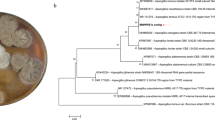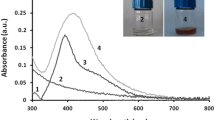Abstract
Aspergillus tubingensis and Bionectria ochroleuca showed excellent extracellular ability to synthesize silver nanoparticles (Ag NP), spherical in shape and 35 ± 10 nm in size. Ag NP were characterized by transmission electron microscopy, X-ray diffraction analysis, and photon correlation spectroscopy for particle size and zeta potential. Proteins present in the fungal filtrate and in Ag NP dispersion were analyzed by electrophoresis (sodium dodecyl sulfate polyacrylamide gel electrophoresis). Ag NP showed pronounced antifungal activity against Candida sp, frequently occurring in hospital infections, with minimal inhibitory concentration in the range of 0.11–1.75 μg/mL. Regarding antibacterial activity, nanoparticles produced by A. tubingensis were more effective compared to the other fungus, inhibiting 98.0 % of Pseudomonas. aeruginosa growth at 0.28 μg/mL. A. tubingensis synthesized Ag NP with surprisingly high and positive surface potential, differing greatly from all known fungi. These data open the possibility of obtaining biogenic Ag NP with positive surface potential and new applications.




Similar content being viewed by others
References
Araújo WL, Maccheroni W Jr, Aguillar-Vildoso CI, Barroso PAV, Saridakis HO, Azevedo JL (2001) Variability and interactions between endophytic bacteria and fungi isolated from leaf tissues of citrus rootstocks. Can J Microbiol 47:229–236. doi:10.1139/cjm-47-3-229
Bradford M (1976) A rapid and sensitive method for the quantitation of microgram quantities of protein utilizing the principle of protein–dye binding. Anal Biochem 72:248–254. doi:10.1016/0003-2697(76)90527-3
Bulet P, Dinamarq JL, Hetru C, Lagueux M, Charlet M, Hegy G, Dorsselaer AV, Hoffmann JA (1993) A novel inducible antibacterial peptide of Drosophila carries an O-glycosylated substitution. J Biol Chem 268:14893–14897, http://hwmaint.jbc.org/cgi/reprint/268/20/14893
CLSI. Clinical and Laboratory Standards Institute (2002) Norma M27-A2. Método de referência para testes de diluição em caldo para a determinação da sensibilidade de leveduras a terapia antifúngica: Norma aprovada. 2. ed. Pennsylvania/Estados Unidos: Edição Wayne, vol. 22, 55 p
Durán N, Marcato PD, Alves OL, De Souza GIH, Esposito E (2005) Mechanistic aspects of biosynthesis of silver nanoparticles by several Fusarium oxysporum strains. J Nanobiotechnol 3:1–7. doi:10.1186/1477-3155-3-8
Durán N, Marcato PD, De Souza GIH, Alves OL, Esposito E (2007) Antibacterial effect of silver nanoparticles produced by fungal process on textile fabrics and their effluent treatment. J Biomed Nanotechnol 3:203–208. doi:10.1166/jbn.2007.022
Durán N, Marcato PD, Ingle A, Gade A, Rai M (2010) Fungi-mediated synthesis of silver nanoparticles: characterization processes and applications. Prog Mycol 425–449. doi:10.1007/978-90-481-3713-8_16
Gade A, Bonde P, Ingle AP, Marcato PD, Durán N, Rai MK (2008) Exploitation of Aspergillus niger for synthesis of silver nanoparticles. J Biobased Mater Bioenerg 2:243–247. doi:10.1166/jbmb.2008.401
González-Mendoza D, Argumedo-Delira R, Morales-Trejo A, Pulido-Herrera A, Cervantes-Díaz L, Grimaldo-Juarez O, Alarcón A (2010) A rapid method for isolation of total DNA from pathogenic filamentous plant fungi. Genet Mol Res 9:162–166. doi:10.4238/vol9-1gmr680
Jiang W, Mashayekhi H, Xing B (2009) Bacteria toxicity comparison between nano- and micro-scaled oxide particles. Environ Pollut 157:1619–1625. doi:10.1016/j.envpol.2008.12.025
Kathiresan K, Manivannan S, Nabeel MA, Dhivya B (2009) Studies on silver nanoparticles synthesized by a marine fungus, Penicillium fellutanum isolated from coastal mangrove sediment. Colloids Surf B Biointerfaces 71:133–137. doi:10.1016/j.colsurfb.2009.01.016
Kathiresan K, Alikunhi NM, Pathmanaban S, Nabikhan A, Kandasamy S (2010) Analysis of antimicrobial silver nanoparticles synthesized by coastal strains of Escherichia coli and Aspergillus niger. Can J Microbiol 56:1050–1059. doi:10.1139/W10-094
Khan SS, Mukherjee A, Chandrasekaran N (2011) Studies on interaction of colloidal silver nanoparticles (SNPs) with five different bacterial species. Colloids Surf B Biointerfaces 87:129–138. doi:10.1016/j.colsurfb.2011.05.012
Kim KJ, Sung WS, Moon SK, Choi JS, Kim JG, Lee DG (2008) Antifungal effect of silver nanoparticles on dermatophytes. J Microbiol Biotechnol 18:1482–1484
Kim KJ, Sung WS, Kyoung SB, Suh BK, Moon SK, Choi JS, Kim J, Lee DG (2009) Antifungal activity and mode of action of silver nano-particles on Candida albicans. BioMetals 22:235–242. doi:10.1007/s10534-008-9159-2
Kimura M (1980) A simple method for estimating evolutionary rates of base substitutions through comparative studies of nucleotide sequences. J Mol Evol 16:111–120. doi:10.1007/BF01731581
Li B, Logan BE (2004) Bacterial adhesion to glass and metal-oxide surfaces. Colloids Surf B Biointerfaces 36:81–90. doi:10.1016/j.colsurfb.2004.05.006
Li WR, Xie XB, Shi QS, Zeng HY, Ou-Yang YS, Chen YB (2010) Antibacterial activity and mechanism of silver nanoparticles on Escherichia coli. Appl Microbiol Biotechnol 85:1115–1122. doi:10.1007/s00253-009-2159-5
Li WR, Xie XB, Shi QS, Duan SS, Ouyang YS, Chen YB (2011) Antibacterial effect of silver nanoparticles on Staphylococcus aureus. BioMetals 24:135–141. doi:10.1007/s10534-010-9381-6
Morones JR, Elechiguerra JL, Camacho A, Holt K, Kouri JB, Ramirez JT, Yacaman MJ (2005) The bactericidal effect of silver nanoparticles. Nanotechnology 16:2346–2353. doi:10.1088/0957-4484/16/10/059
Musarrat J, Dwivedi S, Singh BR, Al-Khedhairy AA, Azam A, Naqvi A (2010) Production of antimicrobial silver nanoparticles in water extracts of the fungus Amylomyces rouxii strain KSU-09. Bioresour Technol 101:8772–8776. doi:10.1016/j.biortech.2010.06.065
Palomino JC, Martin A, Camacho M, Guerra H, Swings J, Portaels F (2002) Resazurin microtiter assay plate: simple and inexpensive method for detection of drug resistance in Mycobacterium tuberculosis. Antimicrob Agents Chemother 46:2720–2722. doi:10.1128/AAC.46.8.2720-2722.2002
Raeder U, Broda P (1985) Rapid preparation of DNA from filamentous fungi. Lett Appl Microbiol 1:17–20. doi:10.1111/j.1472-765X.1985.tb01479.x
Saitou N, Nei M (1987) The neighbor-joining method: a new method for reconstructing phylogenetic trees. Mol Biol Evol 4:406–425. doi:0737-4038/87/0404-0007$02.00
Sondi I, Salopek-Sondi B (2004) Silver nanoparticles as antimicrobial agent: a case study on E. coli as a model for Gram-negative bacteria. J Colloid Interface Sci 275:177–182. doi:10.1016/j.jcis.2004.02.012
Tamura K, Dudley J, Nei M, Kumar S (2007) MEGA4: Molecular Evolutionary Genetics Analysis (MEGA) software version 4.0. Mol Biol Evol 24:1596–1599. doi:10.1093/molbev/msm092
Thompson JD, Higgins DG, Gibson TJ (1994) CLUSTAL W: improving the sensitivity of progressive multiple sequence alignment through sequence weighting, position-specific gap penalties and weight matrix choice. Nucleic Acids Res 22:4673–4680. doi:10.1093/nar/22.22.4673
Warren NG, Shadomy HJ (1991) Yeasts of medical importance. In: Balows A, Hausler WJ Jr, Herrmann KL, Isenberg HD, Shadomy HJ (eds) Manual of clinical microbiology, 5th edn. ASM, Washington
Zhang X, Yan S, Tyagi RD, Surampalli RY (2011) Synthesis of nanoparticles by microorganisms and their application in enhancing microbiological reaction rates. Chemosphere 82:489–494. doi:10.1016/j.chemosphere.2010.10.023
Acknowledgments
This study was supported by Fundação de Amparo à Pesquisa do Estado de São Paulo. Dr. A. Leyva helped with the English editing of the manuscript and Prof. Nelson Durán with PCS equipment.
Conflict of interest
The authors declare that they have no conflict of interest.
Author information
Authors and Affiliations
Corresponding author
Rights and permissions
About this article
Cite this article
Rodrigues, A.G., Ping, L.Y., Marcato, P.D. et al. Biogenic antimicrobial silver nanoparticles produced by fungi. Appl Microbiol Biotechnol 97, 775–782 (2013). https://doi.org/10.1007/s00253-012-4209-7
Received:
Revised:
Accepted:
Published:
Issue Date:
DOI: https://doi.org/10.1007/s00253-012-4209-7




